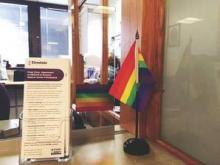“In the privacy of the examination room, ask the patient what name they would like to be called, what pronoun they would like you to use, and in the context of the visit, you use those,” Dr. Levine said.
But because both HIPPA and insurers require a person’s legal name and gender, it is important their EHRs reflect that information, while the dictation makes the patient’s preferences clear.
‘A very important lesson’
But sometimes, as Dr. Jaspan discovered, a notation is simply not enough.
Once Dr. Jaspan’s clinic officially announced it was LGBT friendly, the first patient from that community to enroll was a bearded transgender man who’d had his breasts removed, but still had a uterus and ovaries and so was in need of a pelvic ultrasound.
Dr. Jaspan wrote the script for the radiologist, but Dr. Michele Style, the resident who had first urged him to reach out to the LGBT community, pointed out the peril of not thinking through how the patient would be received at the radiology clinic. She told him that unless they gave fair warning, the radiology tech would call out the patient’s legal name, which would indicate a woman would respond, but instead, it would be a man who would reply.
“Rather than have the tech say, ‘Oh sorry, I have the wrong person,’ and create embarrassment for the patient, we needed a different plan,” he said.
Instead, Dr. Jaspan’s office contacted the radiology staff before the appointment, and they were “overwhelmingly happy to help,” he said. The patient was greeted by a staff member of the radiology clinic who was also part of the LGBT community and was escorted to the exam room without being called by name.
“It was a very important lesson,” Dr. Jaspan said.
Rainbow power
When word got out about plans to open the Pride Clinic at Einstein Medical Center in Philadelphia, Dr. Jaspan started receiving calls from people across the country offering to collaborate, or to give financial assistance.
“It was unbelievable,” Dr. Jaspan said. One important ally was the LGBT brown bag lunch group who met regularly at Einstein and whose members were happy to serve as a focus group for the project. “They also trained our staff on how to answer the phones so LGBT people would immediately feel at ease,” he said.
But what surprised Dr. Jaspan the most was the power of the rainbow. Although he expected the clinic would need some type of overhaul, the focus group assured him that simply by displaying a sticker of a rainbow – long the international symbol of the LGBT community – at the clinic’s entrance, as well as placing rainbow flags on the reception desk and the door of every examination room, LGBT individuals would know they were welcome.
“I thought it was so phenomenal there was that much power in a symbol,” Dr. Jaspan said. “I just couldn’t believe that would make that much difference, but it does.”
From start to finish, including applying for the designation as an LGBT health equality leader by the Human Rights Campaign Foundation and training his staff in how to take information from patients using language that makes no assumptions about their sexual identity or preferences, the process of officially opening his doors to Philadelphia’s LGBT community took a year. “But I was aggressive with it,” Dr. Jaspan added.
Since opening, the clinic has enrolled about 10 LGBT patients on its patient panel, all of whom have access to a network of physicians, including cardiologists, pediatricians, endocrinologists, psychiatrists, and the gynecologic oncologists who now care for the lesbian patient who first presented with advanced-stage cervical cancer.
“I learn something new every day, every single day,” said Dr. Jaspan. “Just because we’ve opened doesn’t mean we’re doing it right, but a [college-aged LGBT patient] we saw the other day said she’d spread the word because she thought we had done everything right.”
Checklist for transgender patient exams
The main barriers to getting basic health care in the lesbian, gay, bisexual, and transgender community are “anticipated, perceived, and actual insensitivity, or rejection,” said Walter O. Bockting, Ph.D., codirector of the LGBT Health Initiative and professor of medical psychology at the New York State Psychiatric Institute and the Columbia University School of Nursing.
Underlying that, he said, is the lack of training in LGBT health concerns for health care professionals, given this cohort’s “marginalization.”



